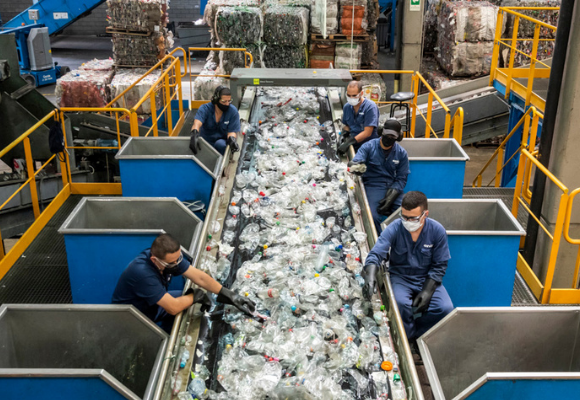Bancolombia 4Q 2017 Net Income Falls 20% Year-on-Year

Medellin-based international banking giant Bancolombia announced February 21 that its fourth quarter (4Q) 2017 net income fell 20.25% year-on-year, to COP$902 billion (US$318 million), from COP$1.13 trillion (US$398 million) in 4Q 2016.
Net loans grew 4.9% in 4Q 2017 versus 4Q 2016 – an indicator of “moderation in credit demand in Colombia,” according to the company.
Meanwhile, investments rose by 25.39% in 4Q 2017 versus 4Q 2016, to COP$16 trillion (US$5.6 billion), according to the company.
For full-year 2017, consolidated net income fell 9% year-on-year, to COP$2.6 trillion (US$916 million). However, compared to 3Q 2017 net income, 4Q 2017 net income rose 100% — to COP$902 billion (US$318 million), the company noted.
Net interest income in 4Q 2017 grew 7.4% year-on-year, to COP$2.65 trillion (US$934 million), “explained by higher volumes of peso-denominated loans and the year-on-year increase in net interest margin,” according to Bancolombia.
Net fees rose 11.3% year-on-year, to COP$658 billion (US$232 million), “mainly driven by an increase in fees related to credit and debit cards, bancassurance, as well as trust services,” according to the company.
Provision charges for the latest quarter hit COP$930 billion (US$328 million) and the coverage ratio for 90-day past due loans was 164.2%. “These provisions allow us to maintain a solid coverage ratio amid a challenging environment, as new past-due loans totaled COP$622 billion [US$219 million] for the [latest] quarter,” the company added.
At year-end 2017, Bancolombia’s assets totaled COP$204 trillion (US$72 billion), up 3.9% year-on-year but down 0.1% compared to 3Q 2017. “The increase in total assets during the quarter is largely explained by the growth in loans, cash and reverse repurchase agreements,” according to Bancolombia.
The company also noted that during 4Q 2017, the Colombian peso depreciated 1.6% versus the U.S. dollar, while over the past 12 months, the peso appreciated 0.6%.
“As of December 31, 2017, our operations in Banco Agricola in El Salvador, Banistmo in Panama and BAM in Guatemala, represented 25% of total gross loans,” according to Bancolombia.
“Gross loans denominated in currencies other than COP — originated by our operations in Central America and the offshore operation of Bancolombia Panama as well as the U.S. dollar-denominated loans in Colombia — accounted for 34% and decreased 2.2% during 4Q 2017 (when expressed in COP), explained mainly by the reduction of the loan portfolio in dollars in Colombia,” according to the company.
“Total reserves (allowances in the balance sheet) for loan losses increased by 5.0% during the quarter and totaled COP$8.223 trillion [US$2.9 billion], equivalent to 5.1% of gross loans at the end of the quarter.
“As of 4Q 2017, Bancolombia’s goodwill and intangibles totaled COP$6.631 trillion [US$2.3 billion], increasing 1.6% compared to 3Q 2017. This variation is explained by the depreciation of the COP against the U.S. dollar during the quarter,” the company added.
At year-end 2017, Bancolombia’s liabilities totaled COP$179 trillion (US$63 billion), falling 0.7% from the end of 3Q 2017 and increasing 3.3% compared to 4Q 2016, according to the company.
Deposits by customers totaled COP$131.96 trillion (US$48 billion) or 73.5% of liabilities at the end of 4Q 2017, increasing 3.2% during the quarter and 5.9% over the last 12 months. The net loans-to-deposits ratio was 115.4% at the end of 4Q 2017, the company added.
“Bancolombia’s funding strategy during the last months has been to reduce the average life of time deposits and promote saving and checking accounts in the consumer segment in order to keep the funding cost at a minimum,” according to the company.
“The objective is to build and maintain ample liquidity and reduce the sensitivity of the balance sheet to cuts in interest rates,” the company added.
“During the quarter, the deterioration of loans increased mainly in the consumer segment as well as some deterioration in SMEs [small and medium enterprises]. Provisions as a percentage of the average gross loans were 2.3% for 4Q 2017 and 2.2% for 2017.
“Bancolombia maintains a strong balance sheet supported by an adequate level of loan loss reserves. Allowances for loan losses totaled COP7.46 trillion [US$2.6 billion], or 4.8% of total loans at the end of 4Q 2017, increasing as compared to 3Q 2017,” the company added.
“Income tax expense was COP$346 billion [US$122 million] for 4Q 2017, increasing 40.9% when compared to the income tax registered in 3Q 2017. Income tax expense for 2017 was COP$1.239 trillion [US$436 million] with and effective tax rate of 31.0%,” the company explained.
“The variation in the income tax between 4Q 2017 and 4Q 2016 was due to the fact that during 4Q 2016, there was a tax reversion in the provision of the income tax after the income statement was finalized, meaning there was certainty about the payable taxes based on the income generated during the fiscal period.
“Usually, this adjustment occurs at the end of each year. Additionally, there was a reversion for the compensation of fiscal credits and the tax reform approved in December 2016, had an impact on deferred taxes because statutory tax rates were lower than those previously estimated,” the company added.
Meanwhile, Bancolombia noted that on December 12, 2017, Standard & Poor’s Global Ratings downgraded the ratings of Bancolombia and its subsidiaries from BBB- to BB+, “in line with a downgrade in the rating of the Republic of Colombia.”
In a subsequent conference call with investment analysts, Bancolombia chief economist Juan Pablo Espinosa added that the bank expects Colombia’s GDP to grow by 2.5% this year — up from 1.8% last year and just 1.6% in 4Q 2017 — the result of “poor performance” in manufacturing, agriculture and retail sectors.
Meanwhile, Colombia is likely to see 3.4% inflation this year, down from earlier forecasts, Espinosa added. As for monetary policy, the Colombian central bank potentially could cut another 0.25% from its current rate levels, he predicted.
















